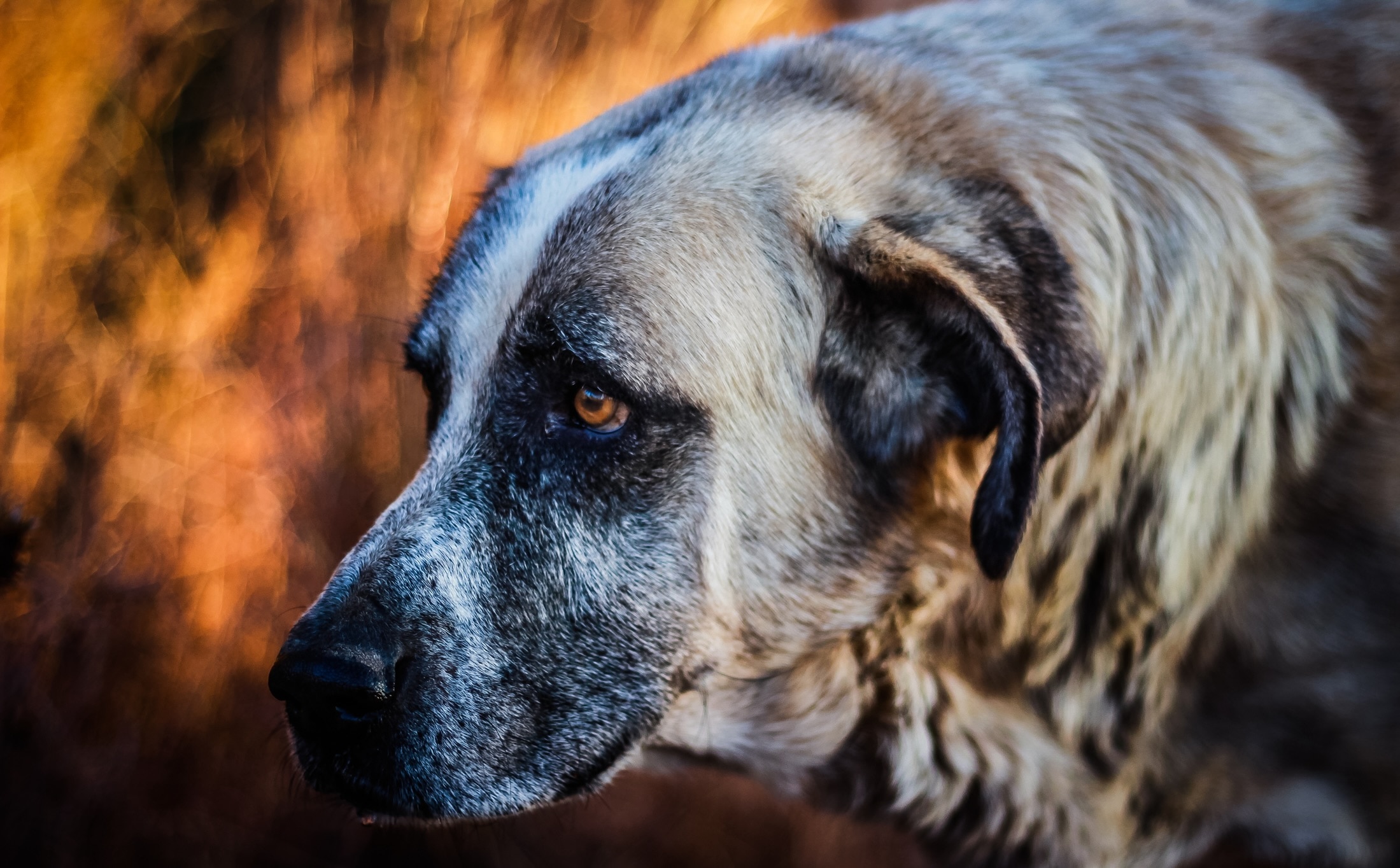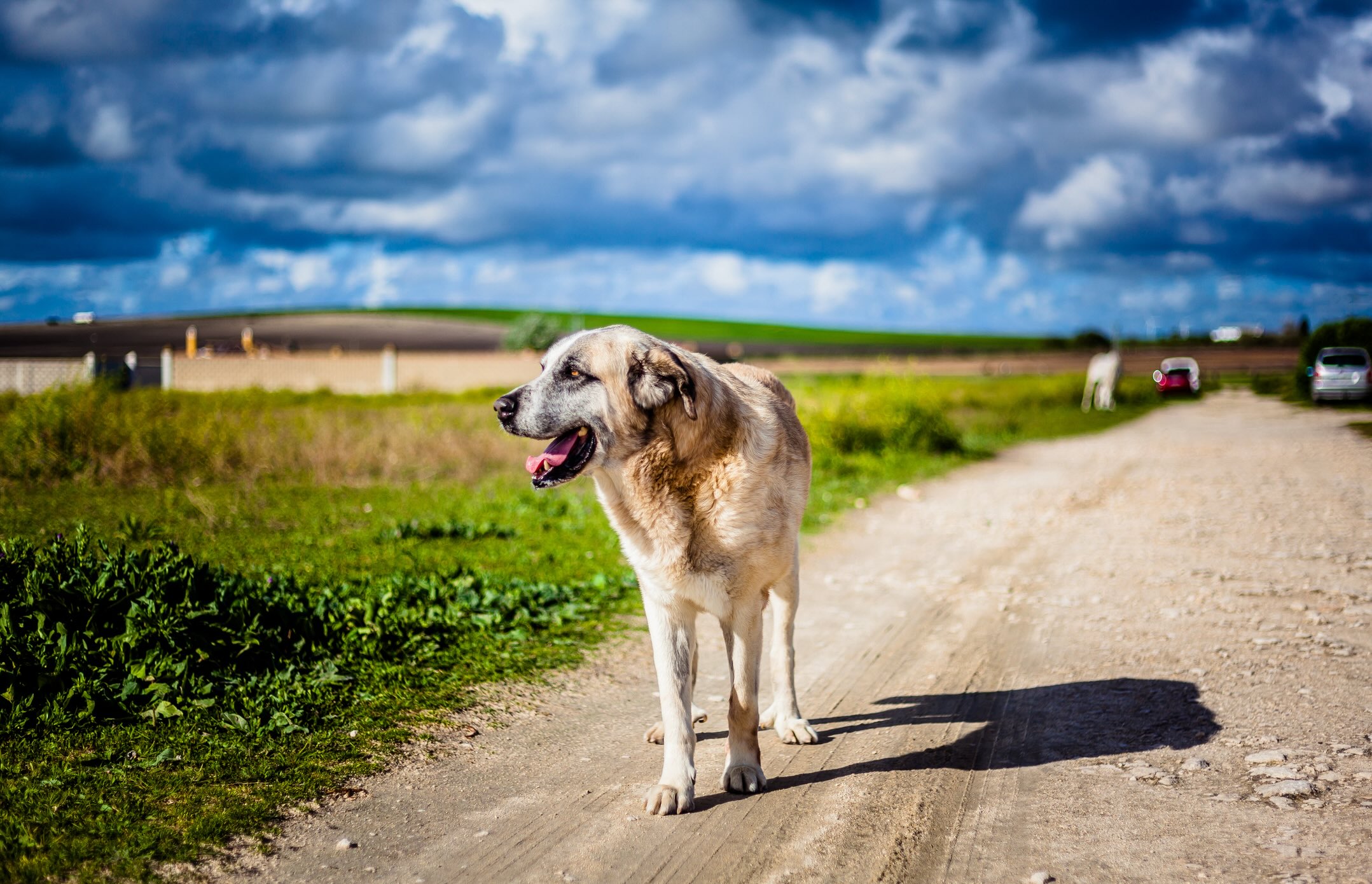Rafeiro do Alentejo
Adobe Stock/Photo Art
The Rafeiro do Alentejo (pronounced hah-FAY-roh doo ah-len-TAY-zhoh) is an estate and herd guardian dog originally from Portugal. Often referred to as Portuguese Mastiffs and Alentejo Mastiffs, these dogs definitely look the part for their historic role as watchful guards.
Rafeiros Alentejanos are a giant dog breed, ranging in size from 25–29 inches and weighing 75–130 pounds or more. They have a broad, bear-like head and a muscular body, and they walk with what their breed standard calls a “heavy, slow roll.”
They are also unique in that they tend to be more active at night, which comes in handy for ensuring the safety of sheep and cattle they were historically tasked with looking after.
But despite their working roles and imposing size, Rafeiro do Alentejo dogs are calm, affectionate, and can succeed as companion dogs with the right families.
Caring for a Rafeiro do Alentejo
Rafeiros Alentejanos may have been bred to guard animals, but that doesn’t mean they can’t thrive as family companions. It does mean, however, that prospective families will need to carefully consider the breed’s particular needs.
The Rafeiro do Alentejo is a giant dog, so a home with enough space for them both inside and outside is ideal. Though they aren’t necessarily high-energy, they do need daily exercise, which is most easily accomplished outdoors.
And because Rafeiros Alentejanos are historic guardians, all outdoor exercise should take place either on a leash or within a securely fenced area—ideally their own yard.
Though highly intelligent and trainable, Rafeiros Alentejanos need experienced dog pet parents who can ensure early socialization and consistent, lifelong, positive training.
Because Rafeiros Alentejanos are historic guardians, all outdoor exercise should take place either on a leash or within a securely fenced area—ideally their own yard.
As for children, the breed is best suited for kids who are old enough to know how to safely interact with a large dog. And while the Rafeiro do Alentejo can share a home with other pets, it’s best if they can grow up alongside their furry companions.
The Rafeiro do Alentejo’s short, straight, dense coat sheds regularly but requires minimal grooming. And as with other large, Mastiff-like dogs, you should expect a bit of drool.
Rafeiro do Alentejo Health Issues

The average Rafeiro do Alentejo lifespan is 12–14 years, which is longer than the average giant-breed lifespan.
They are a generally healthy breed but, like all dogs, can be prone to some health issues. This underscores the importance of working with a breeder who prioritizes health over profit.
Hip Dysplasia
Hip dysplasia is a condition that more commonly affects large dogs. It’s when the hip joint doesn’t develop properly, leading to a loose joint and degenerative joint disease (osteoarthritis). Mild cases can be treated with anti-inflammatory drugs, but severe cases may require surgery.
Common signs of hip dysplasia include:
-
Reluctance to get up or jump
-
Shifting of weight to front legs
-
Loss of muscle mass in the back legs
-
Hip pain
Bloat
Bloat in dogs occurs when gas and food cause the stomach to expand. Bloat can also progress into a condition called gastric dilatation-volvulus (GDV), in which the dog’s stomach twists and cuts off blood flow to the stomach and the spleen.
GDV is painful and a life-threatening emergency, and it’s more common in large and deep-chested breeds like Rafeiros Alentejanos.
It’s important for pet parents to know the signs of bloat and GDV, which include:
-
Retching or dry heaving without vomiting
-
Swollen abdomen
-
Sudden anxiety, pacing, or inability to get comfortable
-
Collapse
If you see these symptoms in your Rafeiro Alentejo, go to an emergency veterinarian immediately.
A gastropexy procedure can be done when your Rafeiro Alentejo is young, often at the same time they are spayed or neutered. This surgery secures the stomach to the abdominal wall, which prevents it from twisting in the future. Ask your vet if your dog is a good candidate for this preventative measure.
What To Feed a Rafeiro do Alentejo
Partner with your veterinarian when choosing the best food for your dog. Your vet can help you identify a food that meets Association of American Feed Control Officials (AAFCO) standards and that’s nutritionally complete for your pet’s age, size, and health history.
In general, Rafeiro do Alentejo puppies should eat a puppy food made for large breeds. Adults can then transition to an adult large-breed formula.
How To Feed a Rafeiro do Alentejo
Most adult Rafeiro do Alentejo dogs should eat two meals a day: once in the morning and again in the evening.
Rafeiro do Alentejo puppies may need an extra feeding or two, for a total for three or four meals every day. Your vet can help you determine the best feeding schedule for your dog’s age.
To reduce the risk of bloat and GDV, pet parents can take certain precautions during mealtimes, such as:
-
Using a slow-feeder bowl to stop your dog from eating too quickly
-
Restricting exercise just before or after your dog eats
-
Avoiding raised food bowls, which may increase the changes of bloat and GDV
-
Feeding your dog multiple smaller meals throughout the day instead of one large meal
How Much Should You Feed a Rafeiro do Alentejo?
For basic information on how much to feed your dog, look at the guide on your dog’s food bag. This gives portions for feeding based on a dog’s weight.
Talking with your vet will give you even better guidance, as they can recommend portions based on other factors as well, including your Rafeiro do Alentejo’s:
-
Age
-
Weight
-
Lifestyle
-
Health needs
Don’t forget to include dog treats in your daily calorie count for a more accurate view of what your pet is eating. Treats should never make up more than 10% of your dog's daily calorie requirements.
Nutritional Tips for Rafeiro do Alentejo Dogs
If your Rafeiro do Alentejo is eating a complete and balanced dog food that’s AAFCO-compliant, they usually won’t need supplementation.
However, nutritional supplements are sometimes used to treat or prevent certain health conditions. Talk to your vet before adding supplements to your dog’s diet.
Behavior and Training Tips for Rafeiro do Alentejo Dogs
Rafeiro do Alentejo Personality and Temperament

The thought of adding a 130-pound cattle guardian to your home may sound a bit daunting, but properly socialized and trained Rafeiros Alentejanos are loyal, confident, and calm dogs.
However, regardless of your training experience, it’s unlikely that you’ll be able to completely override the breed’s instincts, so they should be an expected part of life to some degree. Expect a dog that’s loyal to you but reserved around new people, that likes to roam in a fenced yard, and that may bark to alert you to something new in their environment.
Rafeiro do Alentejo Behavior
Rafeiros Alentejanos are smart working dogs. Without proper socialization, training, and daily outlets for using their body and mind, they can develop unwanted behaviors like barking and chewing.
Bred to work but not exceedingly high in energy, Rafeiros Alentejanos need daily exercise. All outdoor activity needs to take place on a leash or within a securely fenced area.
Rafeiro do Alentejo Training
It’s important to safely expose your Rafeiro do Alentejo puppy to various animals, people, environments, activities, and objects throughout their life. In particular, the first 16 weeks of life is an important learning period for every puppy. This can be particularly important for dogs with historic guardian instincts.
Socializing your pup can help them feel comfortable in a wide variety of settings they’ll encounter throughout their life. Talk to your Rafeiro do Alentejo breeder about how they approach socialization, and ask your veterinarian to suggest activities that are safe for your pet’s age.
Rafeiros Alentejanos have the smarts and skills to excel at training, but their independence (remember, they were bred to work as solo guardians) could lead to some trouble. However, as with all dogs, consistent, positive training that uses rewards is the best approach.
The training process is also an important way to provide the breed with mental stimulation and physical exercise while building the human-animal bond. Treats, play, dog toys, and anything else your pup enjoys can also be used as rewards.
Fun Activities for Rafeiro do Alentejo Dogs
-
Skills training
Rafeiro do Alentejo Grooming Guide
Rafeiro do Alentejo dogs have a double coat of short, thick, straight, dense fur that, according to the breed standard, can be black, wolf gray, fawn, yellow, or brindle.
As with most working dogs, their grooming needs are quite minimal, but you should expect some shedding and perhaps a bit of drool.
Skin Care
Regular grooming can help remove twigs, burs, and other debris that can get caught in your Rafeiro do Alentejo’s coat and irritate their skin. Contact your vet if you notice changes in your dog’s skin or if they seem itchier than normal.
Ask your vet how often you should bathe your dog, as too many baths can strip the skin of healthy oils.
All dogs should be on flea and tick preventative medication, but especially dogs that love to be outside, like the Rafeiro do Alentejo. Ask your vet which preventative is best for your pup.
Coat Care
Rafeiros Alentejanos need to be brushed about once a week, although the frequency may need to increase when they lose their undercoat twice a year.
Eye Care
No special eye care is needed for this breed. Contact your vet if you notice changes in your dog’s eyes or vision.
Ear Care
Talk to your veterinary team about how and how often you should clean your dog’s ears and which ear-cleaning products to use.
Call your vet if you notice signs of an ear infection, such as redness, odor, pain, itchiness, and head shaking.
Considerations for Pet Parents

Here are some questions to consider before adding a Rafeiro do Alentejo to your family:
-
Do I have the time and energy to exercise a large dog every day?
-
Can I provide exercise, either on a leash or within a securely fenced area?
-
Do I have the skills and patience to provide extensive socialization and lifelong training using positive reinforcement?
-
Am I OK with shedding and the possibility of drool?
-
Am I financially prepared to provide veterinary care?
-
Can I provide a dog with a loving home for their lifetime, which could be 14 years or more?
If you can answer these questions with an enthusiastic “Yes!” you may be ready to parent a Rafeiro do Alentejo.
Rafeiro do Alentejo FAQs
How much exercise does a Rafeiro do Alentejo need?
Rafeiros Alentejanos aren’t particularly energetic, but they do need daily exercise. You should plan to provide around one hour of exercise a day, which could include a mix of activities spread throughout the day, such as games of fetch, neighborhood walks, and skills training.
How much does a Rafeiro do Alentejo cost?
The price of a purebred Rafeiro do Alentejo puppy will vary by breeder, but you should generally expect to pay at least $1,000.
Is a Rafeiro do Alentejo a good family dog?
The Rafeiro do Alentejo can be a great family dog when their needs are properly met. These large livestock guardians do best with experienced dog parents who know how to provide extensive socialization and lifelong training.
